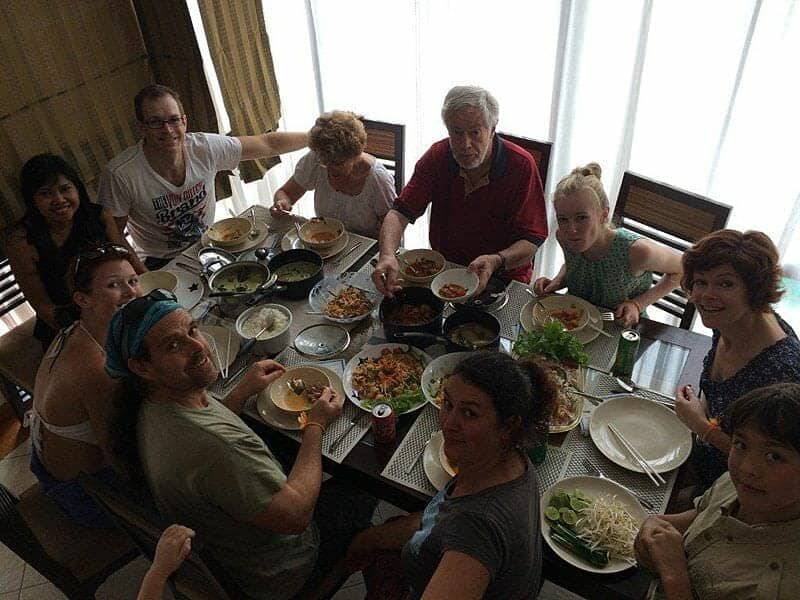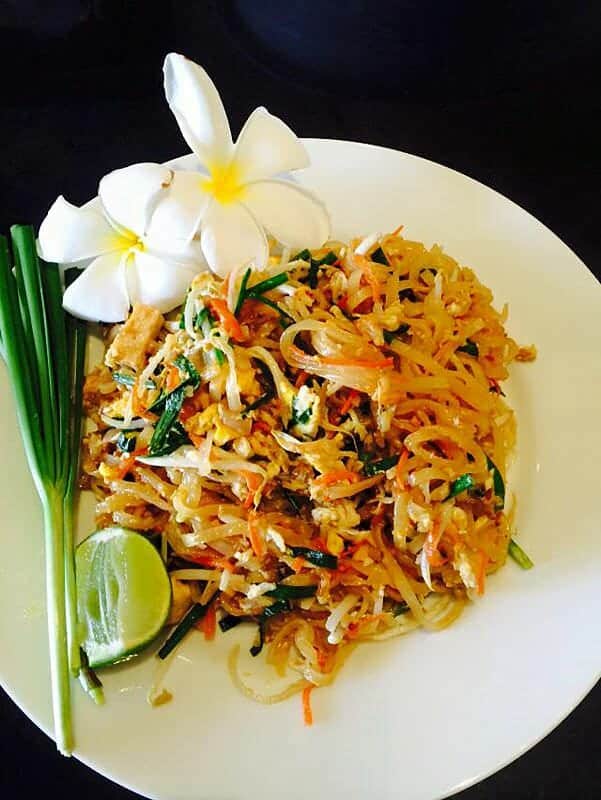While Pichetrungsi pursued a career in entertainment, most recently as an art director in the Imagineering department at the Walt Disney Company, he regularly put in nights and weekends helping his parents. In 2012, he helped revamp the menus; in 2014, he revised the wine program. Fully walking away was never an option.
“Working for Disney was a dream for me. But after grad school, I decided that I never wanted to see [Anajak Thai] go down,” Pichtetrungsi says. “I’d always wanted to preserve my family’s legacy because it meant so much to me. The recipes, the work that my father and mother put in it — it was sealed in my mind that I would die in this restaurant.”
It became clear to Pichetrungsi what his life’s purpose was: to bring his family’s restaurant into the future. This is a challenge for any restaurant owner, but especially one trying to overhaul an old Thai family restaurant in an era when the cuisine has both made enormous strides in America, while remaining identified with weeknight takeout. Pichetrungsi has to navigate between those — making sure it’s not known only for neighborhood takeout Thai, even when takeout is so integral to its survival right now. To his credit, he seems at times to struggle conceptually with Anajak’s identity — battling assumptions of what Thai cuisine should be in this country while trying to keep open what has been a longtime staple in the San Fernando Valley. This has meant retaining popular Anajak dishes, while simultaneously paring down the menu, updating recipes, incorporating locally sourced ingredients, and modernizing the wine list.
To stay relevant, he announces specials — like crispy fried chicken showered with shallots that’s reached almost cult-like status — and has turned the lone two-person table, set out in the alley for a pandemic-era tasting menu experience, into a regular presence on Anajak’s Instagram account.
“I’m trying to serve dry-aged fish, omakase, and other Thai food that has character to it,” Pichetrungsi says. “But right now we’re like a Thai restaurant that operates as a fried chicken shop.”
When Anajak first opened in 1981, it was one of the first Thai restaurants in the Valley. Years before, the popularity of Thai cuisine began to proliferate in West Hollywood; first because Americans visiting Thailand during the Cold War would bring back recipes, and later as Thai students immigrated to the U.S. to attend school. After a campaign by the Thai government to popularize and standardize the cuisine in America in the early 2000s, the number of Thai restaurants became ubiquitous, and disproportionately outsized for the representative Thai population here in the U.S. Today, Los Angeles is home to more Thai people outside of Thailand than anywhere else in the world.
Pichetrungsi says most customers weren’t familiar with Thai cuisine in the early days, the closest estimations being that “it was Chinese food with some spice.” The initial menu included wonton soup and stir-fry dishes that were approachable, and used as a gateway. Justin’s biggest impact has been to leave that approach behind — completely changing Anajak from a neighborhood staple to something more ambitious, in a very Californian way: by building strong relationships with local farmers and purveyors, and by stretching his own insatiable curiosity.
“I see the restaurant as art, as a painting that’s never finished,” he says. “It’s a gallery, it’s not a museum. It rotates. I’m adamant about it changing as much as possible based on what we need, what I love doing.”
Walk with him through the Saturday Santa Monica farmers market, and you see a chef taken by pure joy. Whether it’s collecting flowering yu choy and pea shoots from Chao of Fresno Evergreen Farms, heirloom carrots and romanesco from Weiser Farms, pomelos and cara cara oranges from Valdivia Farms, or oyster mushrooms and papayas from Golden State Papayas, Pichetrungsi is never more animated than when he’s catching up with his farmers. “I could get these vegetables and things from one source, but I’ve worked so hard for these relationships. It’s one of the best parts of my job,” he says.
His weekly farmer’s market greens dish, described only as “chef’s choice”, lends flexibility to the seasonality Pichetrungsi has built his menu around. Sautéed flowering yu choy from Evergreen farms or romanesco from Weiser Farms feature here, while Valdivia tomatoes are tossed in the drunken noodles. Peads and Barnetts pork features prominently throughout the menu, whether in tender pineapple-glazed pork ribs or succulent carnitas tacos, garnished with a vibrant, slightly sour papaya salad that uses papaya sourced from Golden State.
Nearly all his seafood comes from The Joint, one of the most innovative fish markets in L.A. — which just happens to be in Sherman Oaks as well. The three-year-old market specializes in dry-aged fish, which retains a more natural and concentrated flavor, and which Pichetrungsi prizes for his menu. He identifies with the artistry and science that owner Liwei Liao puts into his products, how Liao’s engineering background informs how he tinkers with commercial refrigerators, to turn them into aging chambers for an incredibly diverse selection of fish. And how the resulting product has a more depth of flavor and retains a more taut and tender texture. You’ll see The Joint’s seafood on other menus around town, including Chad Colby’s Antico, Sherman Oaks’ chirashi and omakase staple The Brothers Sushi, and West Hollywood’s Otus Thai Kitchen.
At Anajak, Pichtrungsi uses dry-aged kampachi and fresh scallops for tostadas in aguachile, and dry-aged striped bass in fish tacos on his popular Taco Tuesday menus, which have become a new staple during COVID times — a quintessentially Angeleno mashup. They’re furnished with beautiful, textural microgreens, and topped with a thoughtfully flavored housemade salsa or sauce.
Yet such specials and weekly menus aren’t any less Thai, he says. It’s very much because of Pichetrungsi’s own tastes and whims that Anajak is much more informed by the motherland than many suspect.
“The cuisine is never static in Thailand, especially as compared to here. It’s at 100 miles an hour and never the same,” he adds. “Everyone wants to see Thai food and ‘ethnic cuisines’ as a museum of the culture. But when you go to Thailand, It’s actually like an animated cubist painting. The Thais are not afraid to appropriate the cultures around them. Just look at the different influences in Thailand — there’s every influence under the sun in one place. Indian, Chinese, Malaysian, Laotian. It’s like a buffet. So I see L.A. like that. Our influences are also very much from a buffet.”
It’s Pichetrungsi’s overhaul of Anajak’s wine program that probably was the most personal endeavor. After a trip to Bordeaux and Venice, he fell in love with European wines. Back home, he befriended Joe Capella and Elliott Wang of Everson Royce Bar, who advised him on everything from wine pricing, to strategies for expanding the restaurant’s list. He still worked at Disney when he told his father he was changing the wine selection, which was mostly supermarket-level domestic bottles, plus sake and plum wine.
“Dad, the wine list is so bad. I’m taking it over,” Pichetrungsi recalls telling his father. “And I’m using my own money to buy the first 10 cases. And you will never buy these [other] wines again.”
Today, Anajak’s list now is intensely personal and one of the most interesting in Los Angeles — perhaps because it avoids any dogmatic agenda, which is a win anywhere, but especially for a small neighborhood joint in the Valley, even moreso for a longstanding Thai restaurant.
Pichetrungsi’s own description of his selections are simple wines that are “tasty, well-made, good for the environment and good for you,” though to categorize them, they’d fall anywhere inside a Venn diagram comprising biodynamic, organic, and would-be natural. And of course they’re wines Pichterungsi himself likes, although he also has an instinctive ability to pair them with his multifaceted dishes, things like a bracing spätlese riesling from the Saar Valley’s Hofgut Falkenstein with that fried chicken.
Anajak’s adaptation through the pandemic has been a dramatic one. Before lockdown, the restaurant evoked the comforts of a Thai home, with a loyal, local customer base. As outdoor dining has returned, Pichetrungsi has been able to recapture a little of that friendly neighborhood vibe — albeit in that alleyway, adjacent to the restaurant. While takeout and delivery are available five days a week, à la carte service remains confined to that one small table Fridays through Sundays, with a two-bottle minimum and an omakase-style service.
As for the Thai Taco Tuesdays, a small homage to local Alta California influences, they continue. They’re also the sort of thing that helped propel Anajak to the hallowed Los Angeles Times list of 101 Best Restaurants — namely because Pichetrungsi has turned into the sort of restaurant that is progressing Los Angeles Thai cuisine, such that Angelenos have to reckon with their assumptions about Thai food. All this from its vantage point in the Valley.
It has been a very long transformation, in other words, from when the same paper of record once described Anajak as a hole-in-the-Ventura-Boulevard-wall. Which may be why, when asked what his parents think about what he’s done with the place, Pichetrungsi turns sheepish.
“They were helicopter-ing from day one, but I think I’ve been coming into it. Of course, they’re both very opinionated,” he says. “When they look at all my decisions, sometimes they say, ‘Oh, it’s Justin doing his crazy things.’ Other times, they say, ‘No, don’t do that. That’s more expensive.’ But you know, I think the immigrant survival mentality is actually quite useful these days. So I have to be careful to not disregard their ideas and their concerns.”
Esther Tseng is a food, drinks and culture writer. She has contributed to The Los Angeles Times, Eater, Food & Wine, Civil Eats and more. Follow her on Twitter and Instagram. Follow Resy, too.
This content was originally published here.



